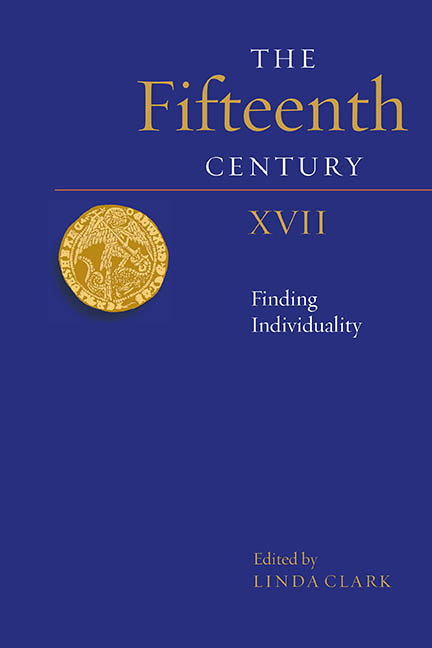Book contents
- Frontmatter
- Contents
- Contributors
- Preface
- Abbreviations
- Royal Wills, 1376–1475
- Propaganda, Piety and Politics in the Fifteenth Century: Henry V’s Vernacular War Letters to the City of London, 1417–21
- ‘To Be of Oon Demeanyng and Unite for the Wele of Your Self and of the Contre There’: Yorkist Plans for the Lordship of Ireland, the Last Phase
- A Mirror for a Princess: Antoine de la Sale and the Political Psyche of Margaret of Anjou
- Margaret of Anjou and the Language of Praise and Censure
- On ‘Peyne of their Lyfes … they Shuld no Verdit gif, but if they Wold Endite the Seid William Tresham of his Owen Deth’: the Murder of Lawyers in Fifteenth-Century England
- ‘Stond Horeson and Yelde thy Knyff’: Urban Politics, Language and Litigation in Late Medieval Canterbury
- ‘In to the Sterre Chambre’: Female Plaintiffs Before the King’s Council in the Reign of Henry VII
- Index
- Contents of Previous Volumes
Propaganda, Piety and Politics in the Fifteenth Century: Henry V’s Vernacular War Letters to the City of London, 1417–21
Published online by Cambridge University Press: 19 August 2020
- Frontmatter
- Contents
- Contributors
- Preface
- Abbreviations
- Royal Wills, 1376–1475
- Propaganda, Piety and Politics in the Fifteenth Century: Henry V’s Vernacular War Letters to the City of London, 1417–21
- ‘To Be of Oon Demeanyng and Unite for the Wele of Your Self and of the Contre There’: Yorkist Plans for the Lordship of Ireland, the Last Phase
- A Mirror for a Princess: Antoine de la Sale and the Political Psyche of Margaret of Anjou
- Margaret of Anjou and the Language of Praise and Censure
- On ‘Peyne of their Lyfes … they Shuld no Verdit gif, but if they Wold Endite the Seid William Tresham of his Owen Deth’: the Murder of Lawyers in Fifteenth-Century England
- ‘Stond Horeson and Yelde thy Knyff’: Urban Politics, Language and Litigation in Late Medieval Canterbury
- ‘In to the Sterre Chambre’: Female Plaintiffs Before the King’s Council in the Reign of Henry VII
- Index
- Contents of Previous Volumes
Summary
Henry V's vernacular war dispatches to the city of London are among the most famous letters of the fifteenth century. Preserved in the Corporation of London's ninth letter book, these seven letters, written between the capture of Touques castle in August 1417 and Henry's advance to Paris in July 1421, publicised news of his conquests as well as his requests for supplies. More remarkably, a series of six vernacular replies from the city of London also survives, from December 1417 to August 1421, rendering the correspondence the oldest sequence of connected English letters yet discovered. They were also some of the first documents issued under the signet to have been written in English, and among the first royal letters known to have been penned in the vernacular since Henry III's dispatches of 1258. This ostensibly momentous significance means that they have been briefly alluded to in almost every account of the development of English in the fifteenth century, including those by Malcolm Richardson, John Fisher, Gwilym Dodd and Malcolm Vale. Yet in spite – or perhaps because – of their remarkable linguistic interest, almost every treatment of the letters has focused on the simple fact that they were in English and the reasons behind this, as opposed to looking in detail at the contents of the letters and asking what their English was being used to communicate. This concern underpinned Paul Strohm's exhortation for more to be said about these dispatches to the citizens of London.
This relative neglect of the letters’ content is even more noteworthy because they are some of the closest surviving documents to texts written by Henry V himself. The signet required the king's personal authentication, and was widely recognised as the one seal which was under his sole control. Henry V's direct involvement with his signet correspondence is evidenced by several letters, including one of October 1419, concerning ‘the safe keeping of the duke of Orleans and other French prisoners’, which were written in his own hand. The presumption of close royal engagement with the signet is particularly apparent in the case of Henry's letters to London. There are 175 signet letters surviving from his reign, yet only ten of them impart news or have any purpose other than to give direct orders
- Type
- Chapter
- Information
- The Fifteenth Century XVIIFinding Individuality, pp. 17 - 34Publisher: Boydell & BrewerPrint publication year: 2020

